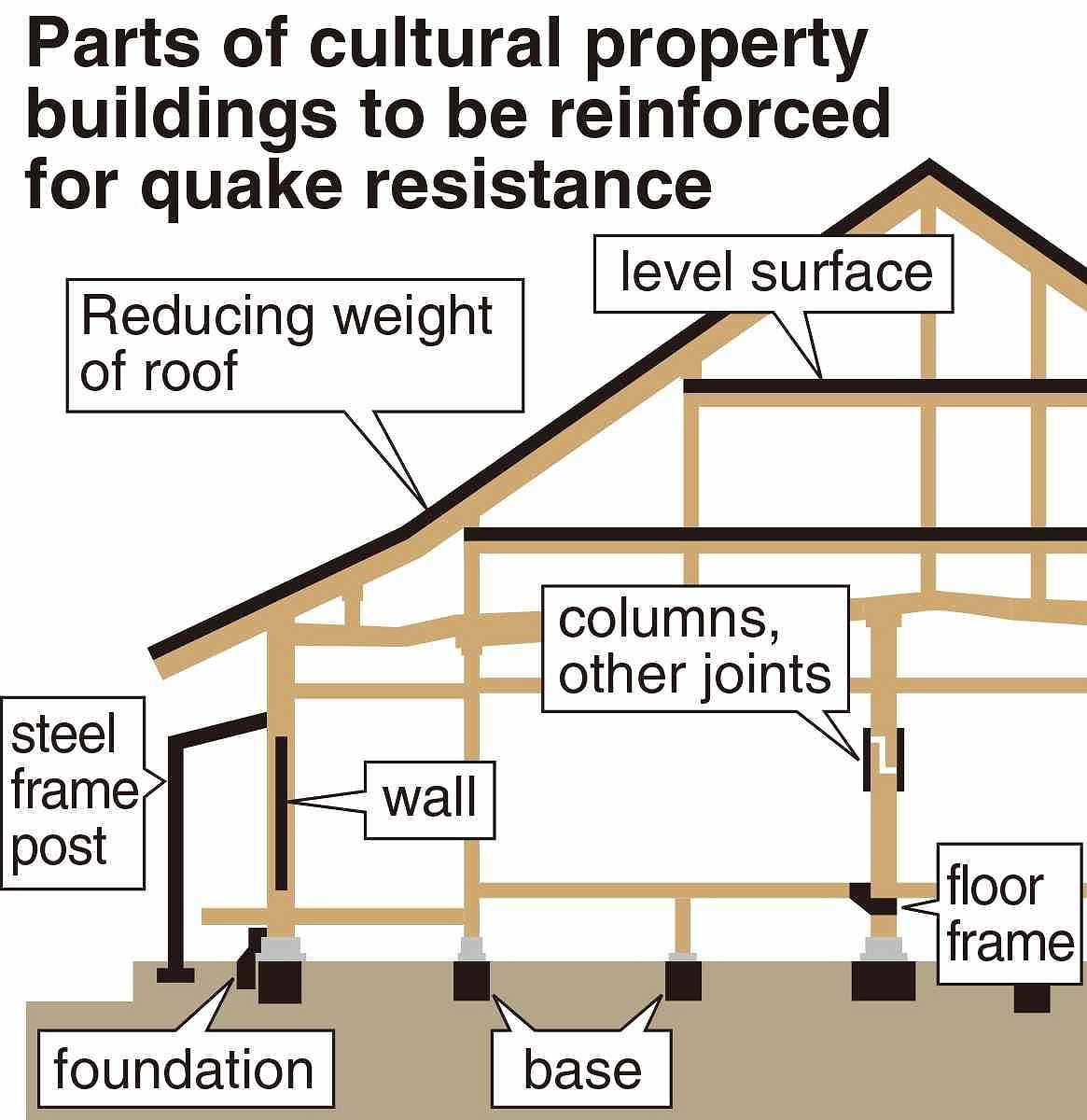Cultural Agency Mulls Amending Seismic Reinforcement Guidelines to Better Protect National Treasures

17:16 JST, March 30, 2024
The Cultural Affairs Agency is considering revising the guidelines for seismic reinforcement of wooden structures designated as national treasures or important cultural properties, the Yomiuri Shimbun has learned.
The government’s decision comes after the collapse of a historical residence in the Noto Peninsula Earthquake — the first destruction of a structure reinforced under current guidelines.
The revised guidelines are expected to emphasize the reinforcement of residential buildings, which are more vulnerable to quakes compared to temples and shrines.
As it stands, seismic reinforcements of structures are currently carried out when in-depth studies confirm any problems found during the preliminary inspection of a building.
The guidelines were established in response to the Great Hanshin Earthquake of 1995 and were partially revised in 2012, a year after the Great East Japan Earthquake. In addition, guidelines and manuals have been formulated to summarize the diagnostic methods and the points to be observed.

The former Kadomi Family Residence in Wajima, Ishikawa Prefecture, which collapsed in the Noto Peninsula Earthquake in January
The Jan. 1 Noto Peninsula earthquake totaled the main building of the former Kadomi Family Residence in Wajima, Ishikawa Prefecture, an important cultural property. The historical residence was central to the community of Kitamaebune merchant boat shipowners in the Edo Period (1603-1867).
The building’s roof had also been damaged in the 2007 earthquake that hit the area and underwent restoration in 2011.
According to the agency, this is the first time that a building seismically reinforced according to current guidelines has collapsed.
Manuals state that residential buildings generally have thinner pillars than shrine and temple buildings, thus are at higher risk of collapse. In response to the collapse following the Jan. 1 Noto quake, the government is considering having talks with experts and raising stronger reminders about criteria that need to be reviewed.
The implementation guidelines follow the quak-resistant standards for buildings set by the Land, Infrastructure, Transport and Tourism Ministry.
The ministry is considering a review of its seismic area coefficient, which is used to calculate the quake-resistant standards for regions of Japan based on past earthquakes that have occurred in each area. Based on discussions with experts, the Cultural Affairs Agency intends to present a direction for reviewing the guidelines, implementation guidelines and manuals in fiscal 2024 or later.
For buildings of national treasures and important cultural properties where an unspecified number of people gather, the agency aims to make 50% of all such buildings quakeproof by fiscal 2025 and 100% by fiscal 2030.
“There is an urgent need to improve the earthquake-proofing of cultural property buildings. We would like to draw on the lessons learned from the Noto Peninsula Earthquake,” a cultural agency official said.
"Society" POPULAR ARTICLE
-

M4.9 Earthquake Hits Tokyo, Neighboring Prefectures
-

Israeli Tourists Refused Accommodation at Hotel in Japan’s Nagano Pref., Prompting Protest by Israeli Embassy and Probe by Prefecture
-

M7.5 Earthquake Hits Northern Japan; Tsunami Waves Observed in Hokkaido, Aomori and Iwate Prefectures
-

Tsukiji Market Urges Tourists to Avoid Visiting in Year-End
-

M5.7 Earthquake Hits Japan’s Kumamoto Pref., Measuring Upper 5 Intensity, No Tsunami Expected
JN ACCESS RANKING
-

Tokyo Economic Security Forum to Hold Inaugural Meeting Amid Tense Global Environment
-

Keidanren Chairman Yoshinobu Tsutsui Visits Kashiwazaki-Kariwa Nuclear Power Plant; Inspects New Emergency Safety System
-

Imports of Rare Earths from China Facing Delays, May Be Caused by Deterioration of Japan-China Relations
-

University of Tokyo Professor Discusses Japanese Economic Security in Interview Ahead of Forum
-

Japan Pulls out of Vietnam Nuclear Project, Complicating Hanoi’s Power Plans






















